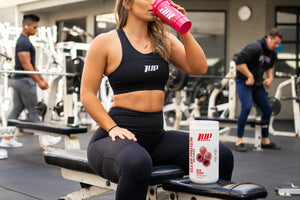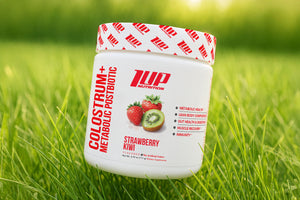When it comes to losing weight, getting fit, or generally improving health & fitness, the vast majority of individuals think that they need to start running (or some other form of cardiovascular exercise).
And, make no mistake, “cardio” (in the traditional sense) behooves the heart, lungs, and circulatory (cardiovascular) system. It can also be a great way to increase energy expenditure and help facilitate faster fat loss during your transformation challenge.
However, it isn’t the be-all, end-all for improving fitness or increasing longevity.
It is one component of a fit and healthy lifestyle, but, by no means is it the only one.
We’re here to discuss how building more muscle can help you live longer.
Where Cardio Falls Short
Cardiovascular (“cardio”) exercise is great for burning calories, increasing mood, enhancing circulation, and supporting overall cardiometabolic health.
But, there are a few limitations.
First, and foremost, cardio doesn’t really help your body build muscle or strength.
Sure, if you’re a couch potato of time immoral then any kind of physical activity, short of walking to the kitchen to get another snack, will help build strength and improve your general fitness.
But, provided that you’re reasonably active, cardio does next to nothing to build muscle or strength.
And, that’s a serious concern because muscle mass naturally declines as you age. Plus, studies indicate that losing muscle leads to decreased function, mobility, and independence… it could even lead to an earlier date with the Grim Reaper.[1]
Traditional cardio also doesn’t burn that many calories, especially for the amount of time that people devote to it each week. If you’re purely looking for calorie burning, you can accomplish similar results in a fraction of the time by performing interval training, circuit training, or just increasing your baseline activity levels each day (such as taking the stairs instead of the escalator).
Third, there is some evidence to suggest that chronic cardio can actually increase feelings of hunger, which can make sticking to a reduced-calorie diet that much more difficult for some individuals.
Now, this doesn’t mean you should abandon cardiovascular exercise entirely. It is good for your heart, all.
It’s just that cardio shouldn’t be the only form of exercise you perform to improve your fitness and physique.
Why Building More Muscle & Strength is Essential for Longevity
Living life as a 50- or 60-something might seem far off in the distance, but it’s coming one way or another, and the choices you make right now will impact the quality and enjoyment of your future self.
It’s a sad fact that most people don’t start taking their health & fitness seriously until it’s almost too late (usually after an illness, injury or some less-than-stellar test results from their doctor).
We’ve all had a loved one or family friend take a bad fall, and afterwards they have a broken arm, foot, hip, etc.
In fact, having less muscle mass and bone density makes individuals more prone to falls and fractures.
Building muscle can help make your body more resilient in the event of a fall or crash in a number of ways.
First, resistance training (as well as other high-impact forms of physical activity such as HIIT or plyometrics) increases bone mineral density. Bone mineral density naturally declines with age and can lead to osteoporosis. This is also more common in women.
Combining resistance training with a nutritious diet and quality vitamins & minerals can help stave off this natural decline in bone mineral density and combat the onset/progression of osteoporosis.
Second, resistance training helps build muscle.
Muscle (besides helping you look better in and out of your clothes) also acts as a natural “shield” and shock absorber for your body, protecting your bones and inner organs should you fall.
Third, the more muscle you have, the better your body is at utilizing and storing glucose. You see, muscle tissue serves as the biggest storage site for glucose in the body (in the form of glycogen).
High blood sugar (hyperglycemia), insulin resistance, and metabolic syndrome are some of the biggest challenges facing people today. Resistance training and building muscle are two of the most powerful things you can do to prevent those conditions from happening (along with eating a healthy diet).
Fourth, lifting weights also serves to improve feelings of mood and well-being as well as overall cognitive function -- the latter of which is well-known to decline with age.
The Bottom Line
Simply put, if you want to live your best life ever, and enjoy your golden years just as much (if not more) than your early years on this planet, you must perform resistance training.
Cardio, while beneficial, is not enough.
Resistance training (“lifting weights”) is key to health and longevity, both mentally and physically.
When you force your muscles to exert themselves against a challenging force, you ignite hundreds of biological pathways that improve your cognitive function, mood, cardiometabolic health, physique, and lifespan.
Now, if you’ve never lifted weights or even performed traditional resistance-training exercises like push ups or bodyweight squats, the thought of choosing an effective training program, let alone building your own, can be extremely daunting, if not downright de-motivating.
Fortunately, you don’t have to!
We provide customized training templates based on YOUR age, gender, goals, preferences, and equipment availability for FREE.
All you need to do is sign up for the 1UP Fitness App, available on both Android and Apple devices, and we’ll help you find the ideal training program based on what YOU want.
References
- de Santana FM, Domiciano DS, Gonçalves MA, Machado LG, Figueiredo CP, Lopes JB, Caparbo VF, Takayama L, Menezes PR, Pereira RM. Association of Appendicular Lean Mass, and Subcutaneous and Visceral Adipose Tissue With Mortality in Older Brazilians: The São Paulo Ageing & Health Study. J Bone Miner Res. 2019 Jul;34(7):1264-1274. doi: 10.1002/jbmr.3710. Epub 2019 May 28. PMID: 30866105.






